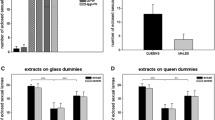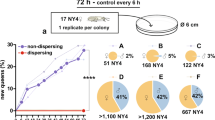Summary
A bioassay is described for a primer pheromone of functional (egg-laying) queens ofS. invicta which inhibits the production of male and female sexuals. The bioassay utilizes standardized units of workers and brood originating from polygyne colonies and the production of sexuals is assessed by the cumulative number of sexualized larvae produced over time. In general, differences in inhibitory capability among treatments can be detected in 2–3 days, making this a rather quick and sensitive bioassay. Whole corpses of dealate queens were nearly as inhibitory as living queens for the 10-day test period, whereas corpses of alate (nonfunctional) queens showed no signs of inhibition. Abdomens of dealate queens alone were strongly inhibitory suggesting that the pheromone originates in the abdomen. In contrast, the head and thorax of dealate queens appeared to be inhibitory for only a short period (ca. three days). Whole corpes of dealate queens placed in small cages which prevented direct contact by workers were not inhibitory, suggesting that the pheromone is relatively nonvolatile.
Resume
On décrit ici un essai biologique concernant une phéromone modificatrice produite par les reines désailées (pondeuses) deS. invicta qui inhibe la production des mâles et des femelles sexuées. Cet essai biologique utilise des unités standardisées formées d'ouvrières et de couvain venant de plusieurs colonies polygynes. La production des sexués est mesurée par le nombre cumulé de larves sexuées qui sont produites au bout de quelques jours. Habituellement les différences entre les performances des divers traitements peuvent être perçues au bout de 2 ou 3 jours, faisant de cet essai un test relativement rapide et sensible. Les cadavres entiers des reines désailées, tuées par congélation, sont presque aussi inhibiteurs que ceux des reines vivantes suivis pendant 10 jours, mais les cadavres des reines vierges ailées ne sont pas inhibiteurs. Les abdomens seuls sont fortement inhibiteurs, suggérant que la phéromone provient de l'abdomen. Par contre la tête plus le thorax des reines désailées ne paraissent être inhibiteurs que pendant une courte période de trois jours environ. Les cadavres des reines désailées enfermés dans de petites cages empêchant le contact direct avec les ouvrières ne sont pas inhibiteurs, suggérant que la phéromone est plutôt non volatile.
Similar content being viewed by others
References
Banks W.A., Lofgren C.S., Jouvenaz D.P., Stringer C.E., Bishop P.M., Williams D.F., Wojcik D.P., Glancey B.M., 1981. — Techniques for collecting, rearing and handling imported fire ants.USDA Sci. Ed. Admin. AAT-S-21, 1–9.
Barbier M., Lederer E., 1960. — Structure chimique de la substance royale de la reine d'abeille (apis mellifica L.).C.R. Acad. Sci. Paris, série D, 250, 4467–4469.
Blum M.S., 1977. — Behavioral responses of Hymenoptera to pheromones and allomones. InShorey H.H., McKelvey J.J., Jr., eds.,Chemical control of insect behavior, 149–167. Wiley, New York.
Blum M.S., Brand J.M., 1972. — Social insect pheromones: their chemistry and function.Am. Zool., 12, 553–576.
Brian M.V., 1979. — Caste differentiation and division of labor. InHermann H.R., ed.,Social insects, vol. I, 121–222. Academic Press, New York.
Butler C.G., Callow R.K., Johnston N.C., 1961. — The isolation and synthesis of queen substance, 9-oxodec-trans-2-enoic acid, a honeybee pheromone.Proc. R. Soc. London B, 155, 417–432.
Butler C.G., Simpson J., 1958. — The source of the queen substance of the honeybee (Apis mellifera L.).Proc. R. Entomol. Soc. London A, 33, 120–122.
Fletcher D.J.C., 1986. — Triple action of queen pheromones in the regulation of reproduction in fire ant (Solenopsis invicta) colonies.Adv. Invert. Repro., 4, 305–316.
Fletcher D.J.C., Blum M.S., 1981 a. — Pheromonal queen control of dealation and oogenesis in virgin queen fire ants.Science, 212, 73–75.
Fletcher D.J.C., Blum M.S., 1981 b. — A bioassay technique for an inhbitory primer phermone of the fire ant,Solenopsis invicta.J. Georgia Entomol. Soc., 16, 352–356.
Fletcher D.J.C., Blum M.S., 1983. — Regulation of queen number by workers in colonies of social insects.Science, 219, 312–314.
Fletcher D.J.C., Cherix D., Blum M.S., 1983. — Some factors influencing dealation by virgin queen fire ants.Insectes Soc., 30, 443–454.
Fletcher D.J.C., Ross K.D., 1985. — Regulation of reproduction in eusocial Hymenoptera.Ann. Rev. Entomol., 30, 319–343.
Hölldobler B., 1978. — Ethological aspects of chemical communication in ants.Adv. Study Behav., 8, 75–115.
Jouvenaz D.P., Allen G.E., Banks W.A., Wojcik D.P., 1977. — A survey for pathogens of fire ants,Solenopsis spp., in the southeastern United States.Florida Entomol., 60, 275–279.
Markin G.P., Dillier J.H., 1971. — The seasonal life cycle of the imported fire ant,Solenopsis saevissima richteri, on the Gulf Coast of Mississippi.Ann. Entomol. Soc. Am., 64, 562–565.
Mirenda J.T., Vinson S.B., 1982. — Single and multiple queen colonies of imported fire ants in Texas.Southwest Entomol., 7, 135–141.
Parry K., Morgan E.D., 1979. — Pheromones of ants: a review.Physiol. Entomol., 4, 161–189.
Sorensen A.A., Fletcher D.J.C., Vinson S.B., 1985. — Distribution of inhibitory queen pheromone among virgin queens of an ant,Solenopsis invicta.Psyche, 92, 57–69.
Vargo E.L., Fletcher D.J.C., 1986. — Evidence of pheromonal queen control over the production of male and female sexuals in the fire ant,Solenopsis invicta.J. Comp. Physiol. A, 159, 741–749.
Vargo E.L., Fletcher D.J.C., 1987. — Effect of queen number on the production of sexuals in natural populations of the fire ant,Solenopsis invicta.Physiol. Entomol., 12, 109–116.
Vargo E.L., Fletcher D.J.C., 1988. — On the relationship between queen number and fecundity in polygyne colonies of the fire ant,Solenopsis invicta Physiol. Entomol. (In press).
Velthuis H.H.W., 1970. — Queen substance from the abdomen of the honeybee queen.Z. Vergl. Physiol., 70, 210–222.
Willer D.E., Fletcher D.J.C., 1986. — Differences in inhibitory capability among queens of the antSolenopsis invicta.Physiol. Entomol., 11, 475–482.
Wilson E.O., 1971. —The insect societies. Belknap Press of Harvard University Press, Cambridge, Mass.
Winston M.L., 1987. —The biology of the honey bee. Harvard University Press, Cambridge, Mass.
Author information
Authors and Affiliations
Rights and permissions
About this article
Cite this article
Vargo, E.L. A bioassay for a primer pheromone of queen fire ants (Solenopsis invicta) which inhibits the production of sexuals. Ins. Soc 35, 382–392 (1988). https://doi.org/10.1007/BF02225813
Received:
Accepted:
Issue Date:
DOI: https://doi.org/10.1007/BF02225813




